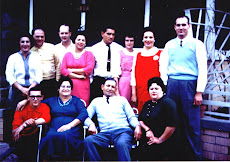Tomorrow is the Feast of St. Lucy, one of the two December celebrations that helped children growing up in Croatian households on Point Cadet take the edge off waiting for Christmas to arrive.
Like the Feast of St. Nicholas which is celebrated on Dec. 6 (read my St. Nicholas post here). St. Lucy's day is a relatively simple, yet much anticipated, occasion honoring one of Europe's most beloved virgin martyrs.
Sveta Lucia, as we called her, lived in Sicily during the late third century, early fourth century. Despite the Roman emperor Diocletian's ban on Christianity, Lucy converted after her prayers to God apparently cured her mother of a bleeding disorder. Lucy pledged to stay chaste and devote her life to Christian acts rather than marry the rich pagan to whom she was betrothed.
Her would-be suitor was so incensed by her rejection, he turned her in to the authorities for bringing food and drink to Christians hiding in caves and tunnels (she allegedly lit her way through the dark with a candle-studded wreath on her head)
After attempts to drag Lucy to a brothel and force her into a life of prostitution failed, as did efforts to burn her at the stake, her frustrated captors finally gouged out her eyes and stabbed her through the neck with a sword.
She was canonized by the Catholic church and today is best known as the patron saint of the blind.
Her feast day is widely celebrated in Sicily, Northern Italy, Croatia, Bosnia as well as Sweden, Finland, Norway and Denmark and several other European countries. Though Scandinavia today is largely Protestant, natives of these countries have loved Lucy ever since Christian missionaries convinced them she was a worthy substitute for the Norse goddess Freya in 1000 AD. Many of Scandinavia's traditional St. Lucy customs of today are actually ancient Norse traditions reattached to our girl Lucy.
Families in Hungary and Croatia sow wheat seeds on the Feast of St. Lucy (or sometimes on the Feast of St. Barbara on Dec. 4) which sprout by Christmas Day and are placed near the Nativity creche. My family never did this. I think this was more of a northern Croatian custom.
My family's St. Lucy's day celebrations unfolded much as they do in northern Italy where Santa Lucia delivers treats to children on the back of a donkey. We left out a bowl with carrots and lettuce for the donkey. St. Lucy left the bowl filled with candy -- and what candy -- fancy imported treats filled with jellies, liqueurs and flavored creams, molded into fantastic shapes and wrapped in beautiful foils.
We also lit candles in a tribute to St. Lucy's symbolic association with the Feast of the Lights -- lighting the way through the darkness of Advent to the joy of Christmas.
There are many regional recipes associated with St. Lucy Day celebrations -- hot buns in Sweden, cuccia, a kind of porridge-y dessert, or biscotti in Sicily. I don't remember my mother making a specific St. Lucy Day treat, but if I were to pick a traditional recipe to celebrate the day, it would be biscotti (also called biscutine) or perhaps this Venetian frico, fried cheese wedges
Santa Lucia Frico (Fried Cheese Wedges)Approximately 3-4 oz. shredded or grated hard cheese depending on the size of the skillet. Parmesan, Machengo Romano or cheddar work best. Semi-soft cheeses like mozzarella and Monterey Jack also work but will make a chewier frico. Very soft cheeses like brie or Camembert will not work and should not be used.
Spread the cheese in a thin, even layer in a 12" non-stick skillet. Some cheese varieties will require more cheese than others to completely cover the bottom of the skillet.
Place the skillet over medium heat and cook until the cheese releases all of its moisture and looks oily and bubbly over its entire surface. The cheese will melt together and form one large cheese pancake.
Use a spatula to lift one edge of the frico - the bottom should be well browned and the cheese should hold together firmly. It shouldn't be stringy or goopy.
Flip the frico and brown the other side for a minute or two, then remove from the pan and place on paper towels to drain. It will firm up and become very crisp as it cools.
Cut into wedges and serve.
Sunday, December 12, 2010
Subscribe to:
Post Comments (Atom)


No comments:
Post a Comment